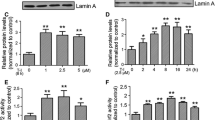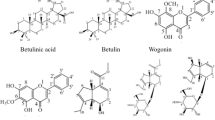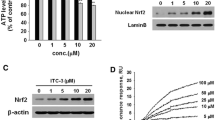Abstract
Dopamine toxicity is an ongoing controversy surrounding the use of levadopa (l-Dopa) in the therapy of Parkinson’s disease. The initial objective of this study was to investigate the potential of neuroprotective botanicals such as Z-ligustilide in reducing the cytotoxicity of dopamine. We surprisingly found that Z-ligustilide potentiated dopamine toxicity in a dopaminergic cell specific manner. Using rat dopaminergic cell line PC12 as a model, we demonstrated that dopamine and Z-ligustilide in combination profoundly induced cell death, although these drugs alone, to a lesser extent, affected the cell viability in a concentration-dependent manner. The synergistic cytotoxicity of dopamine and Z-ligustilide is likely mediated via apoptosis, characterized by DNA fragmentation and chromatin shrinking after 12 h incubation. By measuring the intracellular reactive oxygen species (ROS) and reduced glutathione (GSH), Z-ligustilide and dopamine in combination dramatically enhanced the ROS formation and further depleted reduced GSH, whereas these drugs alone showed much less activity. Importantly, the synergistic cytotoxicity of dopamine and Z-ligustilide could be largely prevented by thiol-containing antioxidant N-acetylcysteine and GSH other than vitamin C and Trolox. Since the cytotoxicity of Z-ligustilide was not reported previously, the results of this study should raise public concerns over the potential risk associated with the combined use of herbal medicines containing Z-ligustilide with l-Dopa in the therapy of Parkinson’s disease.







Similar content being viewed by others
References
Asanuma M, Miyazaki I, Ogawa N (2003) Dopamine- or l-DOPA-induced neurotoxicity: the role of dopamine quinone formation and tyrosinase in a model of Parkinson’s disease. Neurotox Res 5(3):165–176
Basma AN, Morris EJ, Nicklas WJ, Geller HM (1995) l-Dopa cytotoxicity to Pc12 cells in culture is via its autoxidation. J Neurochem 64(2):825–832
Ben-Shachar D, Zuk R, Gazawi H, Ljubuncic P (2004) Dopamine toxicity involves mitochondrial complex I inhibition: implications to dopamine-related neuropsychiatric disorders. Biochem Pharmacol 67(10):1965–1974
Brown RC, Lockwood AH, Sonawane BR (2005) Neurodegenerative diseases: an overview of environmental risk factors. Environ Health Perspect 113(9):1250–1256
Carmel-Harel O, Storz G (2000) Roles of the glutathione- and thioredoxin-dependent reduction systems in the Escherichia coli and Saccharomyces cerevisiae responses to oxidative stress. Annu Rev Microbiol 54:439–461
Chao WW, Hong YH, Chen ML, Lin BF (2010) Inhibitory effects of Angelica sinensis ethyl acetate extract and major compounds on NF-kappaB trans-activation activity and LPS-induced inflammation. J Ethnopharmacol 129(2):244–249
Chen W, Zhao Y, Seefeldt T, Guan X (2008) Determination of thiols and disulfides via HPLC quantification of 5-thio-2-nitrobenzoic acid. J Pharm Biomed Anal 48(5):1375–1380
Dagnino-Subiabre A, Cassels BK, Baez S, Johansson AS, Mannervik B, Segura-Aguilar J (2000) Glutathione transferase M2-2 catalyzes conjugation of dopamine and dopa o-quinones. Biochem Biophys Res Commun 274(1):32–36
Dietz BM, Liu D, Hagos GK, Yao P, Schinkovitz A, Pro SM, Deng S, Farnsworth NR, Pauli GF, van Breemen RB, Bolton JL (2008) Angelica sinensis and its alkylphthalides induce the detoxification enzyme NAD(P)H: quinone oxidoreductase 1 by alkylating Keap1. Chem Res Toxicol 21(10):1939–1948
Fiander H, Schneider H (2000) Dietary ortho phenols that induce glutathione S-transferase and increase the resistance of cells to hydrogen peroxide are potential cancer chemopreventives that act by two mechanisms: the alleviation of oxidative stress and the detoxification of mutagenic xenobiotics. Cancer Lett 156(2):117–124
Guo J, Duan JA, Shang EX, Tang Y, Qian D (2009) Determination of ligustilide in rat brain after nasal administration of essential oil from Rhizoma chuanxiong. Fitoterapia 80(3):168–172
Guo J, Shang EX, Duan JA, Tang Y, Qian D (2011) Determination of ligustilide in the brains of freely moving rats using microdialysis coupled with ultra performance liquid chromatography/mass spectrometry. Fitoterapia 82(3):441–445
Jenner P, Olanow CW (1996) Oxidative stress and the pathogenesis of Parkinson’s disease. Neurology 47(6 Suppl 3):S161–S170
Jing X, Ueki N, Cheng J, Imanishi H, Hada T (2002) Induction of apoptosis in hepatocellular carcinoma cell lines by emodin. Jpn J Cancer Res 93(8):874–882
Meister A, Anderson ME (1983) Glutathione. Annu Rev Biochem 52:711–760
Migheli R, Godani C, Sciola L, Delogu MR, Serra PA, Zangani D, De Natale G, Miele E, Desole MS (1999) Enhancing effect of manganese on l-DOPA-induced apoptosis in PC12 cells: role of oxidative stress. J Neurochem 73(3):1155–1163
Montine KS, Sidell KR, Zhang J, Montine TJ (2002) Dopamine thioethers: formation in brain and neurotoxicity. Neurotox Res 4(7–8):663–669
Offen D, Ziv I, Barzilai A, Gorodin S, Glater E, Hochman A, Melamed E (1997) Dopamine-melanin induces apoptosis in PC12 cells; possible implications for the etiology of Parkinson’s disease. Neurochem Int 31(2):207–216
Olanow CW, Tatton WG (1999) Etiology and pathogenesis of Parkinson’s disease. Annu Rev Neurosci 22:123–144
Peng HY, Du JR, Zhang GY, Kuang X, Liu YX, Qian ZM, Wang CY (2007) Neuroprotective effect of Z-ligustilide against permanent focal ischemic damage in rats. Biol Pharm Bull 30(2):309–312
Polymeropoulos MH, Higgins JJ, Golbe LI, Johnson WG, Ide SE, Di Iorio G, Sanges G, Stenroos ES, Pho LT, Schaffer AA, Lazzarini AM, Nussbaum RL, Duvoisin RC (1996) Mapping of a gene for Parkinson’s disease to chromosome 4q21–q23. Science 274(5290):1197–1199
Prasad KN, Cole WC, Kumar B (1999) Multiple antioxidants in the prevention and treatment of Parkinson’s disease. J Am Coll Nutr 18(5):413–423
Przedborski S (2005) Pathogenesis of nigral cell death in Parkinson’s disease. Parkinsonism Relat Disord 11(Suppl 1):S3–S7
Qi H, Siu SO, Chen Y, Han Y, Chu IK, Tong Y, Lau AS, Rong J (2010) Senkyunolides reduce hydrogen peroxide-induced oxidative damage in human liver HepG2 cells via induction of heme oxygenase-1. Chem Biol Interact 183(3):380–389
Rong J, Tilton R, Shen J, Ng KM, Liu C, Tam PK, Lau AS, Cheng YC (2007) Genome-wide biological response fingerprinting (BioReF) of the Chinese botanical formulation ISF-1 enables the selection of multiple marker genes as a potential metric for quality control. J Ethnopharmacol 113(1):35–44
Rong J, Cheung CY, Lau AS, Shen J, Tam PK, Cheng YC (2008) Induction of heme oxygenase-1 by traditional Chinese medicine formulation ISF-1 and its ingredients as a cytoprotective mechanism against oxidative stress. Int J Mol Med 21(4):405–411
Schafer FQ, Buettner GR (2001) Redox environment of the cell as viewed through the redox state of the glutathione disulfide/glutathione couple. Free Radic Biol Med 30(11):1191–1212
Shavali S, Sens DA (2008) Synergistic neurotoxic effects of arsenic and dopamine in human dopaminergic neuroblastoma SH-SY5Y cells. Toxicol Sci 102(2):254–261
Sidell KR, Olson SJ, Ou JJ, Zhang Y, Amarnath V, Montine TJ (2001) Cysteine and mercapturate conjugates of oxidized dopamine are in human striatum but only the cysteine conjugate impedes dopamine trafficking in vitro and in vivo. J Neurochem 79(3):510–521
Spencer JP, Jenner P, Daniel SE, Lees AJ, Marsden DC, Halliwell B (1998) Conjugates of catecholamines with cysteine and GSH in Parkinson’s disease: possible mechanisms of formation involving reactive oxygen species. J Neurochem 71(5):2112–2122
Stokes AH, Hastings TG, Vrana KE (1999) Cytotoxic and genotoxic potential of dopamine. J Neurosci Res 55(6):659–665
Stokes AH, Lewis DY, Lash LH, Jerome WG 3rd, Grant KW, Aschner M, Vrana KE (2000) Dopamine toxicity in neuroblastoma cells: role of glutathione depletion by l-BSO and apoptosis. Brain Res 858(1):1–8
Tanner CM, Ben-Shlomo Y (1999) Epidemiology of Parkinson’s disease. Adv Neurol 80:153–159
Wang J, Du JR, Wang Y, Kuang X, Wang CY (2010) Z-ligustilide attenuates lipopolysaccharide-induced proinflammatory response via inhibiting NF-kappaB pathway in primary rat microglia. Acta Pharmacol Sin 31(7):791–797
Zeng HP, Wang TT, Chen W, Wang CY, Chen DF, Shen JG (2008) Characterization of chemical components in extracts from Si-wu decoction with proliferation-promoting effects on rat mesenchymal stem cells. Bioorg Med Chem 16(9):5109–5114
Zhang J, Kravtsov V, Amarnath V, Picklo MJ, Graham DG, Montine TJ (2000) Enhancement of dopaminergic neurotoxicity by the mercapturate of dopamine: relevance to Parkinson’s disease. J Neurochem 74(3):970–978
Zhao DL, Zou LB, Lin S, Shi JG, Zhu HB (2007) Anti-apoptotic effect of esculin on dopamine-induced cytotoxicity in the human neuroblastoma SH-SY5Y cell line. Neuropharmacology 53(6):724–732
Zhou ZD, Lim TM (2009) Roles of glutathione (GSH) in dopamine (DA) oxidation studied by improved tandem HPLC plus ESI-MS. Neurochem Res 34(2):316–326
Ziv I, Melamed E, Nardi N, Luria D, Achiron A, Offen D, Barzilai A (1994) Dopamine induces apoptosis-like cell death in cultured chick sympathetic neurons—a possible novel pathogenetic mechanism in Parkinson’s disease. Neurosci Lett 170(1):136–140
Acknowledgments
This work was supported by the Seed Funding for Basic Research (University of Hong Kong) (to J.R.).
Conflict of interest
None.
Author information
Authors and Affiliations
Corresponding author
Rights and permissions
About this article
Cite this article
Qi, H., Zhao, J., Han, Y. et al. Z-Ligustilide Potentiates the Cytotoxicity of Dopamine in Rat Dopaminergic PC12 Cells. Neurotox Res 22, 345–354 (2012). https://doi.org/10.1007/s12640-012-9319-6
Received:
Revised:
Accepted:
Published:
Issue Date:
DOI: https://doi.org/10.1007/s12640-012-9319-6




